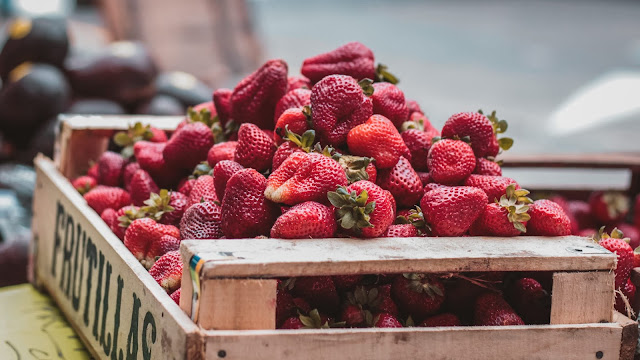5 Reasons to Choose Simple Food
A friend sent me a chicken soup recipe that calls for 16 ingredients. Sixteen. Including ditalini pasta, whatever that is. (Okay, I Googled it. It's the pasta I've seen in macaroni salads.)
I have a small kitchen, which means I don't store ten shapes of pasta. I don't store six kinds of flour. I don't keep 25 herbs and spices, since I'd probably use the same eight or nine all the time while the others just got stale. I don't want to shop for a bunch of ingredients, and I don't want to fool with washing, prepping, and measuring all of them.
I have a small kitchen, which means I don't store ten shapes of pasta. I don't store six kinds of flour. I don't keep 25 herbs and spices, since I'd probably use the same eight or nine all the time while the others just got stale. I don't want to shop for a bunch of ingredients, and I don't want to fool with washing, prepping, and measuring all of them.
 |
The food you eat can be either the safestAnn Wigmore |
Simple food is natural ingredients our bodies recognize.
Michael Pollan, author of Food Rules: An Eater's Manual,* suggests that we shouldn't eat anything our great-grandmothers wouldn't recognize as food. Well, my great-grandmother would have recognized fried frog legs, lard, and biscuits with sausage gravy, which might not be what Pollan has in mind! What he's talking about is real food – as close to natural, unmodified, and unprocessed as you can get. Organic seasonal fruits and vegetables, whole grains, beans, nuts and seeds, cheeses and plain yogurt, free-range eggs and meats, wild-caught fish.
* This is a reader-supported blog. If you purchase with my links, I may earn a small commission.
That doesn't mean you could never buy packaged food. Canned tuna, canned tomatoes, rolled oats, and frozen fruits and vegetables are all processed and packaged, but they're still real food.
Simple food is more nutritious.
Simple food is more nutritious.
Have you noticed how certain foods or nutrients get labeled "super" or "evil," and we dutifully change our eating habits to match? I remember when butter was declared unhealthy, and my mother switched to margarine. My grandmother predicted that someday margarine would be considered unhealthy. Of course she was right – it's made with trans fats.
Highly processed foods can be nutrition disasters, but the food industry is skilled at promoting foods free of the "bad" ingredients or fortified with the "good" ones. For example:
- Craisins, dried cranberries marketed as a naturally fat- and cholesterol-free snack, contain lots of refined sugar and none of the iron, potassium, and other nutrients found in plain old raisins.
- Reduced-fat peanut butter, which saves all of 10 to 20 calories per serving over nut butter made solely from roasted peanuts, has added corn syrup, sugar, and hydrogenated oils.
- Oroweat Oat Nut Bread does contain oats and hazelnuts, but its primary ingredient is enriched wheat flour, a refined product which lacks the fiber and more than a dozen nutrients found in whole wheat.
Simple food won't break your budget.
A lot of simple food can be found in the produce section or in bulk bins. In contrast, many processed foods (especially snacks and beverages) are quite expensive. Organic dairy, eggs, and meats can be pricey, but eating smaller portions of those things is actually healthier for you, and it's easy to get a lot of your protein from plant sources.
Simple food can be raw.
Think of large salads made with all kinds of dark, leafy greens, sliced cucumbers, grape tomatoes, shredded carrots, thin slices of red onion, and shavings of Parmesan cheese, drizzled with a dressing made of olive oil, balsamic vinegar, and a dab of Dijon mustard. Other no-cook options include hummus with celery and carrot sticks, half an avocado filled with fresh salsa, or cottage cheese topped with fresh, seasonal fruits and sprinkled with raw nuts.
Simple food is quick and easy to cook.
Or it can cook slowly, without a lot of supervision.
I like old-fashioned rolled oats cooked with a diced apple or pear, or scrambled eggs on whole grain toast. Or pinto beans simmered in a slow cooker with diced onions and bell pepper, garlic and crushed tomatoes, salt, pepper, chili powder, cumin, and a pinch of cinnamon.
My favorite chicken soup recipe calls for some leftover chicken (originally roasted with garlic, black pepper, rosemary sprigs, and a lemon – or I use part of a rotisserie chicken from the deli), organic chicken broth, chopped onion, carrots, and celery, salt, pepper, and bay leaves. Sometimes I add a pinch of red pepper flakes. Healthy, easy, affordable – and a lot fewer than 16 ingredients. My husband likes grilled or baked pork chops marinated in fresh lime juice, olive oil, and crushed garlic. Four ingredients and simply scrumptious.
And simple desserts? A juicy sweet tangelo. A bowl of picked-this-morning local strawberries topped with plain Greek yogurt and a drizzle of honey. A tree-ripened peach. A baked Honeycrisp or Pink Lady apple. Or a piece of 70% extra-dark chocolate.
It's real delicious simple food.
Updated January 2023





All the recipes I make as a vegetarian are ones that call for a very short list of ingredients. I find that the more ingredients called for add stress in many ways, plus I don't like the final product as more than a few ingredients taste "cluttered" to me. I once watched a TV series on cooking/food in Italy, and one of the themes that was repeatedly stressed is that Italians tend to use very few ingredients in their recipes and focus on quality/freshness of a few ingredients instead. That made a huge impression on me and resulted in a huge shift in how I cook. Now that I cook like an Italian, the cooking part of my life is far less stressful. It needs to be as I cook every night of the week, except for one when we go out for a treat. And if I see a new recipe, I automatically disqualify it if there are too many ingredients.
ReplyDelete"Cook like an Italian" - I love it. Your idea is exactly what I had in mind. Thanks for your comment, Rachael.
Delete